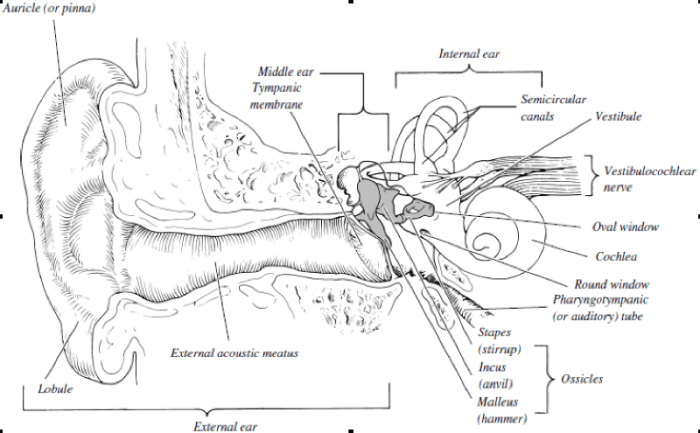Exercise 25 review sheet special senses hearing and equilibrium – Embark on an exploration of Exercise 25 Review Sheet: Special Senses – Hearing and Equilibrium, a comprehensive guide that unveils the intricate mechanisms underlying our auditory and vestibular systems. Delve into the anatomy of the ear, unravel the mysteries of sound transmission, and discover the remarkable role of hair cells in hearing.
Prepare to navigate the complexities of equilibrium and balance, deciphering the vestibular system’s mastery in maintaining spatial orientation. Explore common hearing impairments, their causes, and the profound impact they can have on communication and well-being. Gain insights into clinical evaluation techniques, such as audiometry and electronystagmography, empowering you to diagnose and manage ear disorders effectively.
Structure of the Ear

The ear, a remarkable organ of perception, is composed of three primary regions: the outer, middle, and inner ear. Each region serves a distinct function in the intricate process of hearing and equilibrium.
The outer ear, visible on the sides of the head, comprises the auricle (pinna) and external auditory canal. The auricle collects sound waves and channels them into the external auditory canal, which leads to the middle ear.
The middle ear, located behind the eardrum, consists of three small bones known as the ossicles: the malleus, incus, and stapes. These ossicles transmit sound vibrations from the eardrum to the inner ear.
The inner ear, a complex labyrinthine structure, houses the cochlea and vestibular system. The cochlea is a spiral-shaped tube that plays a crucial role in hearing, while the vestibular system is responsible for maintaining balance and spatial orientation.
Sound Transmission
Sound waves, upon entering the outer ear, travel through the external auditory canal and strike the eardrum, causing it to vibrate. These vibrations are transmitted to the ossicles in the middle ear, which amplify and transfer them to the oval window of the inner ear.
The oval window, connected to the fluid-filled cochlea, transmits vibrations to the perilymph and endolymph within the cochlea, creating a traveling wave that stimulates hair cells along its length.
Hearing Mechanisms
The cochlea is lined with specialized sensory cells called hair cells. These hair cells, embedded in the basilar membrane, are tuned to different frequencies of sound. When sound waves reach the cochlea, they cause the basilar membrane to vibrate, stimulating the hair cells.
The hair cells convert mechanical vibrations into electrical signals, which are then transmitted to the brain via the auditory nerve. The brain interprets these signals as sound, allowing us to perceive and differentiate various sounds.
The tonotopic organization of the cochlea ensures that different frequencies of sound are processed in specific regions along its length, enabling us to discriminate between sounds of different pitches.
Equilibrium and Balance
The vestibular system, located within the inner ear, is responsible for maintaining balance and spatial orientation. It consists of three semicircular canals and two otolith organs: the utricle and saccule.
The semicircular canals detect rotational movements of the head, while the otolith organs sense linear acceleration and gravity. Together, these structures provide the brain with information about the body’s position and orientation in space, enabling us to maintain balance and navigate our surroundings.
Hearing Impairments, Exercise 25 review sheet special senses hearing and equilibrium
Hearing impairments, ranging from mild to profound, can arise from various causes, including genetic factors, exposure to excessive noise, infections, and certain medications.
Conductive hearing loss occurs when sound waves are not efficiently transmitted through the outer or middle ear, while sensorineural hearing loss results from damage to the cochlea or auditory nerve. Mixed hearing loss involves a combination of both conductive and sensorineural components.
Hearing loss can significantly impact communication, social interactions, and overall well-being.
Clinical Evaluation of Hearing and Equilibrium
Audiometry is a standard procedure used to assess hearing function. It involves presenting pure tones at various frequencies and intensities and measuring the individual’s ability to detect and identify them.
Electronystagmography (ENG) is a test that evaluates the vestibular system by recording eye movements in response to specific stimuli. It helps diagnose disorders that affect balance and spatial orientation.
These tests provide valuable information for diagnosing and managing ear disorders, guiding appropriate treatment plans.
Interventions for Hearing and Equilibrium Disorders
Hearing aids are commonly used to amplify sound and improve hearing in individuals with conductive or sensorineural hearing loss. Cochlear implants, surgically implanted devices, can restore hearing in cases of severe to profound sensorineural hearing loss.
Assistive listening devices, such as FM systems and captioning services, can also enhance communication for individuals with hearing impairments.
For vestibular disorders, rehabilitation strategies may include exercises and balance training to improve stability and reduce dizziness.
Top FAQs: Exercise 25 Review Sheet Special Senses Hearing And Equilibrium
What are the three main regions of the ear and their functions?
The outer ear collects sound waves, the middle ear amplifies and transmits sound to the inner ear, and the inner ear converts sound waves into electrical signals and maintains balance.
How do hair cells convert sound waves into electrical signals?
Hair cells in the cochlea bend in response to sound waves, triggering the release of neurotransmitters that generate electrical signals.
What is the role of the vestibular system in maintaining balance?
The vestibular system detects head movements and gravity, sending signals to the brain to maintain spatial orientation and balance.
What are some common types of hearing impairments?
Common hearing impairments include conductive hearing loss (e.g., due to earwax blockage), sensorineural hearing loss (e.g., due to damage to the cochlea), and mixed hearing loss (a combination of both).

